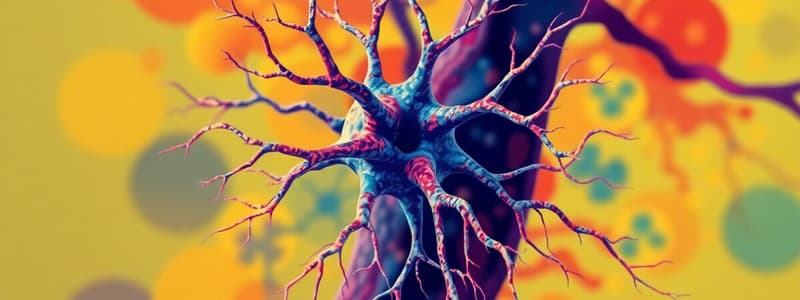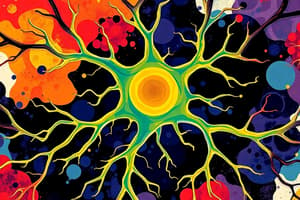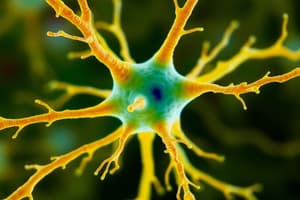Podcast
Questions and Answers
What are the parts and function of the nervous system?
What are the parts and function of the nervous system?
The nervous system is made up of the brain, spinal cord, and nerves. It controls all of your body's actions, from breathing to thinking.
Who can cite other situations/experiences related to the one shown in the picture?
Who can cite other situations/experiences related to the one shown in the picture?
A person who has experienced a similar situation, like a sudden scare or a reflex action.
With which hand did you catch the ruler faster when your eyes were opened? When your eyes were closed?
With which hand did you catch the ruler faster when your eyes were opened? When your eyes were closed?
The hand with eyes open should be faster.
Did you catch the ruler faster with your eyes opened or closed?
Did you catch the ruler faster with your eyes opened or closed?
Explain why a message
moving along nerve pathways takes time?
Explain why a message moving along nerve pathways takes time?
Describe the nerve pathway that the message followed when you saw the ruler fall?
Describe the nerve pathway that the message followed when you saw the ruler fall?
What are the parts of a nerve cell? Describe its function?
What are the parts of a nerve cell? Describe its function?
How can a nerve cell or neuron carry impulses from one part of the body to another?
How can a nerve cell or neuron carry impulses from one part of the body to another?
The [blank] is the basic unit of the nervous system
The [blank] is the basic unit of the nervous system
What are the basic parts of a neuron?
What are the basic parts of a neuron?
What does the axon do?
What does the axon do?
What do dendrites do?
What do dendrites do?
What does the cell body of a neuron contain ?
What does the cell body of a neuron contain ?
During rest (polarized state), the inside of the membrane is negative.
During rest (polarized state), the inside of the membrane is negative.
At activation (reversal of polarity) the inside of the membrane is positive.
At activation (reversal of polarity) the inside of the membrane is positive.
The sodium-potassium pump is responsible for restoring the resting membrane potential after depolarization.
The sodium-potassium pump is responsible for restoring the resting membrane potential after depolarization.
What does RMP stand for?
What does RMP stand for?
What is the threshold?
What is the threshold?
What is an action potential?
What is an action potential?
The nerve impulse is sent by neurotransmitters.
The nerve impulse is sent by neurotransmitters.
What is a synapse?
What is a synapse?
What is a stimulus?
What is a stimulus?
What is a response?
What is a response?
What is reaction time?
What is reaction time?
What do sensory neurons do?
What do sensory neurons do?
What does an effector do?
What does an effector do?
What does the brain do in the process of receiving a stimulus?
What does the brain do in the process of receiving a stimulus?
All of the following situation shows a response to stimulus EXCEPT?
All of the following situation shows a response to stimulus EXCEPT?
Which is an example of a delayed reaction situation?
Which is an example of a delayed reaction situation?
Motor neurons transmit impulses in the PNS or Peripheral Nervous system. In line with this function, which does not belong to the group?
Motor neurons transmit impulses in the PNS or Peripheral Nervous system. In line with this function, which does not belong to the group?
Which shows the correct order of stimuli – response scenario?
Which shows the correct order of stimuli – response scenario?
All of the following health programs and activities can help promote healthy lives in relation to human nervous system care EXCEPT.
All of the following health programs and activities can help promote healthy lives in relation to human nervous system care EXCEPT.
Flashcards
What is the nervous system?
What is the nervous system?
The nervous system is a complex network of cells that transmits information throughout the body, enabling it to respond to its surroundings.
What is the function of the nervous system?
What is the function of the nervous system?
The nervous system is responsible for receiving and processing information from the environment, and for controlling movement, thoughts, and emotions.
What is the basic unit of the nervous system?
What is the basic unit of the nervous system?
The basic unit of the nervous system is the neuron or nerve cell. These specialized cells are responsible for transmitting signals throughout the body.
What is a nerve impulse?
What is a nerve impulse?
Signup and view all the flashcards
What are dendrites?
What are dendrites?
Signup and view all the flashcards
What is the cell body of a neuron?
What is the cell body of a neuron?
Signup and view all the flashcards
What is the axon?
What is the axon?
Signup and view all the flashcards
What is a synapse?
What is a synapse?
Signup and view all the flashcards
What are neurotransmitters?
What are neurotransmitters?
Signup and view all the flashcards
What are sensory neurons?
What are sensory neurons?
Signup and view all the flashcards
What are motor neurons?
What are motor neurons?
Signup and view all the flashcards
What is a stimulus?
What is a stimulus?
Signup and view all the flashcards
What is a response?
What is a response?
Signup and view all the flashcards
What is reaction time?
What is reaction time?
Signup and view all the flashcards
What is the peripheral nervous system (PNS)?
What is the peripheral nervous system (PNS)?
Signup and view all the flashcards
What is the central nervous system (CNS)?
What is the central nervous system (CNS)?
Signup and view all the flashcards
What is the brain?
What is the brain?
Signup and view all the flashcards
What is the spinal cord?
What is the spinal cord?
Signup and view all the flashcards
What is a reflex?
What is a reflex?
Signup and view all the flashcards
What happens when you touch a hot object?
What happens when you touch a hot object?
Signup and view all the flashcards
What is a reflex arc?
What is a reflex arc?
Signup and view all the flashcards
Why is the nervous system important?
Why is the nervous system important?
Signup and view all the flashcards
What can you do to maintain a healthy nervous system?
What can you do to maintain a healthy nervous system?
Signup and view all the flashcards
What is newborn screening?
What is newborn screening?
Signup and view all the flashcards
What is a stimulating brain care development program?
What is a stimulating brain care development program?
Signup and view all the flashcards
Why is a proper diet and exercise important?
Why is a proper diet and exercise important?
Signup and view all the flashcards
What should you avoid to maintain a healthy nervous system?
What should you avoid to maintain a healthy nervous system?
Signup and view all the flashcards
Study Notes
Nerve Cell Structure and Function
- Neurons are the basic units of the nervous system
- Neurons have specialized structures for transmitting information
- Parts of a neuron include dendrites, cell body, axon, axon terminal, and neurotransmitters
Nerve Cell Parts
- Dendrites: Branching extensions receiving signals from other neurons
- Cell body (soma): Contains the nucleus and other organelles
- Axon: Long, slender projection transmitting the signal away from the cell body
- Axon terminal: Branches at the end of an axon, releasing neurotransmitters
- Myelin sheath: Fatty insulation surrounding some axons, increasing signal speed
- Nodes of Ranvier: Gaps in the myelin sheath, crucial for saltatory conduction
Types of Neurons
- Sensory neurons (afferent neurons): Carry signals from sensory receptors to the central nervous system (CNS)
- Motor neurons (efferent neurons): Carry signals from the CNS to muscles or glands
- Interneurons: Connect sensory and motor neurons within the CNS, processing information
Impulse Transmission
- Neurotransmitters are chemical messengers released at the axon terminals to transmit impulses across synapses
- Synapses are the gaps between neurons
- Impulse transmission is crucial for communication within the nervous system
Nerve Impulse
- The nerve impulse is an electrochemical signal
- During neural transmission, there is a change in electrical potential across neuron membranes which causes a nerve impulse. This shift in electrical potential is dependent on changes in membrane ion concentration inside and outside of the membrane
- This leads to a change in the electrical polarity and causes a wave of depolarization and repolarization, a nerve impulse
- Impulses are transmitted through neurotransmitters that are produced at the axon terminals when an impulse comes
Action Potential
- Resting membrane potential (RMP): The neuron's electrical charge at rest (typically -70 mV)
- Depolarization: The inside of the membrane becomes more positive
- Repolarization: The inside of the membrane returns to negative; it goes back to the resting state
- During the action potential, the membrane changes from a state of polarity to a more positive state, and then goes back to a state of potential
Reflex Arc
- A rapid, involuntary response to a stimulus, bypassing the brain
- Sensory receptor -> Sensory neuron -> Interneuron -> Motor neuron -> Effector
Reaction Time
- The time taken for a response after a stimulus
- Many factors influencing reaction time include physical and psychological state
Types of Nervous System
- Central nervous system (CNS): Brain and spinal cord
- Peripheral nervous system (PNS): Nerves connecting to the CNS
Forms of Membrane Potential
- During Rest: The resting membrane potential (RMP) occurs when the cell is at rest, in a polarized state
- Upon Stimulation: Receiving a stimulus causes a change in membrane potential, including threshold, action potential, depolarization, repolarization and hyperpolarization
Stimulus and Response
- Stimulus: Anything that causes a change in living organisms
- Response: The effect of the stimulus
- Receptors are specific structures that monitor internal and external stimuli
- Effectors are the parts that respond to the stimuli and messages
Studying That Suits You
Use AI to generate personalized quizzes and flashcards to suit your learning preferences.




